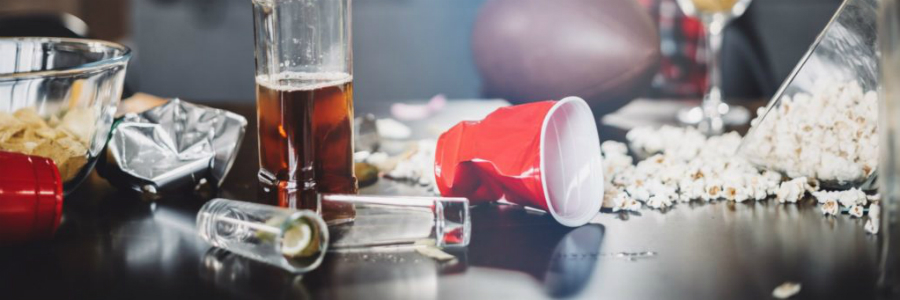What happens to the body when we drink alcohol?
Leading into the weekend, many of us look forward to that first glass of wine after work on a Friday, or that beer after footy is over on a Saturday. But it can be so easy for that glass of wine to lead to a bottle, or that beer turns into a 6 pack, plus a scotch and coke or two…
Current Australian guidelines recommend no more than one alcoholic drink per day for women, and no more than two for men.
However, consuming alcohol above these quantities is very common.
So, what happens to your body when you drink alcohol?
Here are 5 things that may make you reconsider reaching for that extra glass.
Alcohol and Weight Gain
Drinking alcohol doesn’t directly cause weight gain, chances are if you are a regular drinker, there will be a few extra kilograms being carried. The liver needs to process alcohol before it can be burned off. As a result, alcohol stops your body from burning fat.
Furthermore, whilst alcohol is high in calories, it can increase feelings of hunger and reduce those of satiety. Plus, having that extra drink will often lead to poor food choices; that stop off at the local takeaway store on the way home is a common occurrence on a big night, and chances are that choosing the healthiest option won’t be front of mind.
Alcohol and Bad Skin
Drinking alcohol can affect our skin in a number of ways. Alcohol it is a diuretic. This means it increases the rate we lose fluid, or in other words, it dehydrates us.
Those tiny fine lines that are hidden when we are well hydrated suddenly become much more pronounced after a big night. Secondly, it can result in break-outs (especially if you’re prone to forgetting to take off your makeup) due to the sugar content of many alcoholic drinks.
A dull complexion and bloated, puffy face are other common signs of overindulging, an appearance most of us want to avoid!
Alcohol, Cancer and Heart Disease
Excessive alcohol consumption increases the risk of a number of different diseases, including heart disease, liver disease and cancer, particularly mouth, pharynx, larynx, oesophagus, stomach, bowel, liver and breast cancer.
Alcohol and Brain Damage
Slurred speech, difficulty walking in a straight line, impact on vision and even blacking out are all well known (and scary), short-term effects of alcohol consumption.
But the effects aren’t just short term. Alcohol’s impact on the brain can also be long term as well. Drinking six drinks in a sitting can result in damage to memory, especially for those under the age of 25, due to the vulnerability of the brain at this age.
Furthermore, the longer heavy drinking has occurred, the more likely it is those memory problems will occur. And ladies take note – you are more vulnerable than men to many of the medical consequences of alcohol use.
It’s not all bad news. Our brains are great at repairing themselves. Alcoholics with cognitive impairment show at least some improvement in brain structure and functioning after a year of no alcohol. And, whilst some people take much longer, this means that the damage may be reversible.
Let’s not forget Hangovers!
I couldn’t write an article about drinking alcohol without writing about the short-term impacts of over-consumption; the hangover.
The smell of the alcohol coming out of your pores; nausea; vomiting; headaches… The wasted days spent in bed.
High intakes of alcohol increase pressure on the immune system. Sleep patterns are disrupted, stopping you from moving into REM (aka deep) sleep. Add to that the depressive effect of alcohol and overdoing it ain’t pretty!
So what to do?
- Alternate your alcohol with water.
- Eat something before you go out.
- Avoid skipping meals.
- Avoid getting into rounds.
- Be mindful of how much you’re pouring into your glass when at home.
- Ensure to include alcohol-free days.
- Plan something for the next morning that you don’t want to do hungover, to help deter going over the top the night before.
As party season comes around
Every year I find I am spending more time talking about alcohol consumption and the health impacts it has.
We’ve already looked at some of the health impacts of drinking alcohol.
Now let’s look at the caloric increase that occurs as a result of drinking alcohol.
Putting the calories from alcohol into perspective
Here’s a guide of how much physical activity it would take to burn off some common alcoholic drinks*
The below exercise needs are approximate and based on a 70kg person:
1 MEDIUM GLASS OF CHAMPAGNE – 104CAL
- 12 minutes of Cycling
- 11 minutes of Dancing
- 27 minutes of Vacuuming
1 BOTTLE CHAMPAGNE – 520CAL
- 74 minutes of Swimming (leisurely)
- 89 minutes of Weight training
- 50 minutes of Running at an average pace
1 SCHOONER BEER – 114CAL
- 20 minutes of Golf
- 20 minutes of Weight training
- 14 minutes of Jogging
PREMIXED VODKA DRINK – 255 CAL
- 46 minutes of Cricket
- 27 minutes of Tennis (playing singles)
- 19 minutes of Running Intervals
WINE, 1 MEDIUM GLASS – 110CAL
- 15 minutes of Basketball
- 38 minutes of Hatha Yoga
- 27 minutes of Walking
WINE, 1 BOTTLE – 549CAL
- 65 minutes of Aerobics
- 40 minutes of Running Intervals
- 4 hours and 21 minutes of Ironing
SCOTCH AND COKE – 268 CAL
- 30 minutes of Dancing
- 33 minutes of Jogging
- 61 minutes of Gardening
ESPRESSO MARTINI – 285 CAL
- 81 minutes of Lawn Bowls
- 31 minutes of Dancing
- 35 minutes of Jogging
VODKA SODA – 61 CAL
- 9 minutes of Swimming (leisurely)
- 6 minutes of Running at an average pace
- 10 minutes of Lawn mowing
It is important to remember that the above numbers are estimations.
The number of calories burnt can vary significantly depending on a number of factors, including:
- How hard you’re working in your training session.
- Your body size.
- Muscle mass.
- How new to the activity you are.
Whilst some of the numbers may seem small to start with (a 6-minute run to burn off your vodka?), it’s not unusual for more than one to be consumed for many individuals. That hour of aerobic style exercise to burn off said bottle of wine may sound easy to manage if your favourite burger is thrown in (approximately 500 Cal), suddenly an extra hour of that activity is thrown in, plus you likely have a cracking headache… and (nearly) an extra day (or half day, depending on your body size) of calories has appeared.
Another way to look at alcohol consumption is in the realms of food
100 calories are equal to 4 squares of chocolate or 20 crisps, or a medium banana, or 1 vodka and cola.
200 calories will get you 16 fries or 500mL bottle cola.
300 calories are enough for a croissant, or 2 slices of cheese and tomato pizza or a full cream milk hot chocolate.
Whilst I am all for people having a great time, excessive alcohol consumption, along with the unnecessary calories that are added, being mindful of the health impacts of overindulging is important.
*Physical activity requirements calculated from WCRF, and calories in alcohol from Easy Diet Diary.
Here are my favourite tips for keeping your alcohol intake in check:
Alternate each alcoholic drink with a glass of water
Alcohol is a diuretic, meaning it will increase how quickly your body loses water. Increasing your water intake can help reduce the amount of alcohol you consume, and increase your hydration levels if you are choosing to overindulge.
Avoid getting into rounds
This is an easy way to drink more than you planned… especially if you’re with others who tend to drink more than you do!
Avoid Soft Drinks with Alcohol (other than soda water)
Soft drinks are loaded with excess sugar! Consumption of these will likely make you feel worse the next day.
Include at least 2 ALCOHOL-FREE days each week
Doing so will help give your body, in particularly your liver, a break.
Start drinking late
Try not to start drinking early; delaying until later in the day means fewer hours of drinking overall, which usually means fewer drinks as well!
AND REMEMBER; IF YOU DO CHOOSE TO DRINK
The recommendations for daily consumption are:
- for women, less than 1 standard drink per day
- for men, less than two standard drinks per day
Chloe McLeod is an Accredited Sports Dietitian, Accredited Practicing Dietitian and co-owner of Health & Performance Collective. Chloe specialises in food intolerance, sports nutrition and nutrition for arthritis and autoimmune conditions with over 10 years experience in the industry. Follow her on instagram @chloe_mcleod_dietitian





 © Pace Athletic
© Pace Athletic